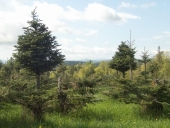













List of Bryant RedHawk's Epic Soil Series Threads We love visitors, that's why we live in a secluded cabin deep in the woods. "Buzzard's Roost (Asnikiye Heca) Farm." Promoting permaculture to save our planet.
 1
1








 1
1
















 1
1




List of Bryant RedHawk's Epic Soil Series Threads We love visitors, that's why we live in a secluded cabin deep in the woods. "Buzzard's Roost (Asnikiye Heca) Farm." Promoting permaculture to save our planet.
 2
2




Moderator, Treatment Free Beekeepers group on Facebook.
https://www.facebook.com/groups/treatmentfreebeekeepers/





 1
1




 1
1




Bryant RedHawk wrote:Hau Nicole, So you don't think that higher than normal January temperatures followed by cold (snow) isn't a weather factor?
If the tree did better after adding that duck, I would agree that there is a sign that your soil needs some amendments to increase what it is lacking at the moment.
You might also try some mycorrhizae and perhaps some bacteria additions along the way, those will really help the soil provide the tree what it needs.
Michael Cox wrote:All that grass growing right up close to them won't help either. Grass is strongly competitive towards fruit trees, and has a big impact in the first few years while they are getting established. I would be mulching a much larger area around the trees.
 . Little kids take up most of my time! After the pictures, I scythed and sickled the grass short. I've also planted mint under the tree, in hopes it would take over. The mint has yet to do what mint is supposed to, and hasn't taken over yet
. Little kids take up most of my time! After the pictures, I scythed and sickled the grass short. I've also planted mint under the tree, in hopes it would take over. The mint has yet to do what mint is supposed to, and hasn't taken over yet  .
. 



















List of Bryant RedHawk's Epic Soil Series Threads We love visitors, that's why we live in a secluded cabin deep in the woods. "Buzzard's Roost (Asnikiye Heca) Farm." Promoting permaculture to save our planet.





![Filename: IMG_20180828_110418.jpg
Description: Crazy amounts of growth on that mulberry tree. I guess it really did need some nutrient! [Thumbnail for IMG_20180828_110418.jpg]](/t/87652/a/64427/thumb-IMG_20180828_110418.jpg)




Nicole Alderman wrote:Could it be because my soils are damp? They're gravely loam, so they drain well, but this winter especially, it rained a LOT. Could this have caused dieback to the limbs?
'Every time I learn something new, it pushes some old stuff out of my brain.'





|
Eliminate 95% of the weeds in your lawn by mowing 3 inches or higher. Then plant tiny ads:
12 DVDs bundle
https://permies.com/wiki/269050/DVDs-bundle
|



